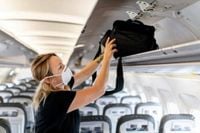For years, the skies have been regarded as the safest place to travel, but a growing body of evidence suggests that many flights may be exposing crew and passengers to toxic fumes with devastating consequences. According to an extensive investigation by The Wall Street Journal, thousands of so-called "fume events" have been reported to the Federal Aviation Administration (FAA) since 2010, with the frequency and severity of these incidents rising sharply in recent years—particularly aboard the widely used Airbus A320 jets.
These "fume events" occur when contaminated air, often carrying vaporized engine oil or hydraulic fluid, leaks into the airplane’s cabin and cockpit. The result? Crew members and passengers have suffered a range of serious health effects, including traumatic brain injuries and nerve damage eerily reminiscent of the chronic traumatic encephalopathy (CTE) seen in battered NFL players. The problem is not isolated: since 2010, airlines have filed thousands of reports with the FAA warning of toxic fumes seeping into cockpits and cabins, as reported by The Wall Street Journal.
One particularly harrowing incident unfolded on February 24, 2025, when a Delta jet bound for South Carolina was forced to return to Atlanta after thick white smoke began pouring through the overhead vents. Panic swept the cabin as passengers and crew scrambled for air. Over the loudspeaker, a flight attendant advised, "Breathe through your clothing, stay low," as the pilots declared an emergency. The scene was captured on video by passenger Kristin Morris, showing the cabin filling up with a smoky haze.
Flight attendants and pilots have been among the most severely affected. Florence Chesson, a JetBlue flight attendant, recounted to The Wall Street Journal her own terrifying experience on a flight to Puerto Rico in December 2017. She described a "dirty feet" aroma that filled the cabin, followed by a sensation of being drugged. Another crew member struggled to breathe and eventually vomited before both were rushed to the hospital after landing. Chesson recalled, "I felt like I was talking gibberish. I remember being very repetitive, saying, 'What just happened to me? What just happened to me?'" The next morning, she woke up with the sensation that her brain was on fire and later was diagnosed with a traumatic brain injury and permanent nerve damage.
Chesson’s neurologist, Dr. Robert Kaniecki, compared her symptoms to a "chemical concussion extraordinarily similar" to those suffered by NFL linebackers after brutal hits. He told The Wall Street Journal that over the past two decades, he has treated more than 100 flight attendants and about a dozen pilots for brain injuries tied to toxic cabin air exposures. Kaniecki described repeated exposures as "micro concussions" that prime crew members for a major event—"the straw that breaks the camel’s back." Dr. Robert Harrison, an occupational medicine specialist at the University of California, San Francisco, echoed these concerns, stating, "This is real, this can’t be just all in their heads."
The problem is not limited to a single airline or aircraft type. FAA records reviewed by The Wall Street Journal show that the rate of fume events has climbed to nearly 108 per million departures. At JetBlue and Spirit—both of which primarily operate Airbus jets—the frequency of A320 fume incidents spiked by 660% between 2016 and 2024. These events are not always obvious; sometimes they manifest as a faint odor, while other times, the evidence is unmistakable, such as thick smoke or crew members collapsing in the aisle.
Manufacturers and regulators have been slow to respond. Airbus and Boeing have both acknowledged that oil and hydraulic fluid can leak from engines and vaporize at extreme heat, releasing toxic compounds into the air supply. However, both insist publicly that their aircraft meet all airworthiness requirements. In a statement to The Wall Street Journal, a Boeing spokesperson said, "The cabin air inside Boeing airplanes is safe. There is no indoor environment that is free from ‘contaminants.’" Airbus, for its part, told customers last year that its "Project Fresh" redesign could cut cabin odor events by 85% with a relocated vent, but the fix will only apply to new jets starting in 2026.
Despite these assurances, internal communications paint a more troubling picture. In a 2017 email revealed in a lawsuit, Boeing quality inspector Steven Reiman warned that oil leaks could make "aircrew sick to the point of death." FAA investigators admitted in an internal report last year that bleed air contaminants are toxic, after reviewing two Southwest Airlines flights in 2023 that hit large birds, causing oil to leak into the bleed air system. Pilots on those flights could have been exposed to deadly chemical levels in as little as 39 seconds.
Modern jet oils contain organophosphates, a class of chemicals once used as nerve agents in warfare, according to a 2018 warning from an FAA safety inspector. A recent FAA-funded study found that chemicals such as formaldehyde and tridecane exceeded workplace safety limits when vaporized at engine heat levels. Joseph Allen, a Harvard air-quality specialist, commented to The Wall Street Journal, "It’s clear to me that there’s concerning data in these studies, and it’s inappropriately downplayed."
Some airlines have taken steps to address the issue. Delta, for example, has replaced auxiliary power units on more than 80% of its A320 family fleet as of 2025. A Delta spokesperson told The New York Post, "Smoke, fumes and odor events are exceedingly rare though we take each seriously, as we do with all matters of safety." JetBlue, meanwhile, stated, "We take nothing more seriously than the safety and health of our crewmembers and customers… We would never operate an aircraft if we believed it posed a health or safety risk to our customers or crewmembers."
Nevertheless, flight attendants like Florentina Tudor, formerly of Wizz Air, report frequent fume events and a culture of denial. Tudor said a captain dismissed a sick colleague as “just pretending” before medics carried the attendant away. "At some point I asked myself, is it just me, am I paranoid?" she confided to The Wall Street Journal.
The FAA maintains that incidents of fumes entering cabins are rare and that "the agency has strict cabin air standards, and studies have shown cabin air is as good as or better than the air found in offices and homes." Airlines are required to report these incidents, and the FAA investigates the causes before allowing aircraft to return to service. Still, the rising number of reports and the severity of the health impacts have prompted calls for more robust action from both regulators and manufacturers.
As the aviation industry continues to grapple with these revelations, passengers and crew are left to wonder: how safe is the air they breathe at 35,000 feet? For those who have suffered life-altering injuries, the answer is already painfully clear.






